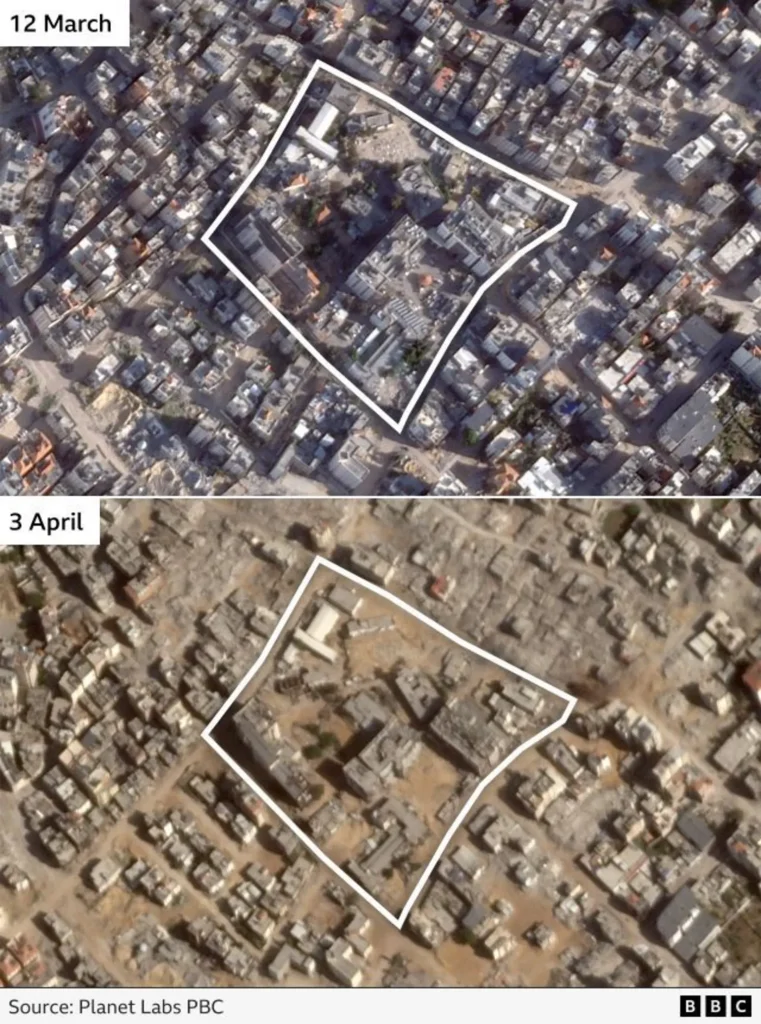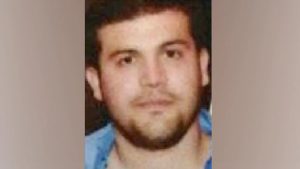Mass graves and body bags: al-Shifa hospital after Israel withdrew its forces

After Israeli forces pulled out of Gaza City’s vast al-Shifa hospital complex on 1 April, following their second raid there, stunned Palestinians who pored over the burnt-out ruins said it reeked of death.
During the past eight months of war, hospitals have come under repeated attack, with Israel claiming they are used as bases by Hamas; something the group denies.
But events at al-Shifa – once the biggest and best equipped medical facility in the Gaza Strip – have arguably been the most dramatic.
The two-week surprise raid, launched after Israel said Hamas had regrouped at the site, was described by the Israeli government as “precise and surgical”.
Its spokesman, Avi Hyman, asserted that it had set “the gold standard of urban warfare”. He said: “We took out over 200 terrorists. We apprehended over 900 terrorists with not a single civilian casualty.”
With decaying bodies sticking out of the sand piled up by combat bulldozers in the courtyards of al-Shifa, the claim that there had been no civilian casualties was immediately questioned.
In recent weeks, four mass graves have been uncovered at the site, with Palestinian search teams saying that several hundred bodies have been found.
We have worked with a journalist in Gaza to follow developments.

“We’ve extracted martyrs, many of whom are decomposed and completely unidentifiable,” a Palestinian Civil Defence worker, Rami Dababesh told us grimly on 8 May as he stood by a line of white plastic body bags at al-Shifa, wearing a face mask and full protective gear.
“We’ve found corpses of women, children and individuals without heads as well as torn body parts,” he added.
The Civil Defence lacks forensic equipment and expertise, but its teams have been using photos and videos to document the remains. A director, Dr Mohamed Mughir, told us there were suspicious finds; describing how “signs of field executions, binding marks, gunshot wounds to the head and torture marks on the limbs were observed on the bodies of some martyrs”.
The UN Security Council has expressed “deep concern” at the discovery of mass graves at both al-Shifa and Nasser hospital in southern Gaza. Along with the US and the European Union, it has called for an independent investigation into possible war crimes.
The Israel Defense Forces (IDF) says that during its raids of the Gaza hospitals, its soldiers exhumed bodies that Palestinians had buried earlier as part of its search for the remains of some 250 hostages captured during the deadly Hamas attacks on Israel on 7 October.
It maintains bodies were examined respectfully and those not belonging to Israeli captives were returned to their place.
However, at least some of the corpses found recently at al-Shifa were those of patients who died during Israel’s latest military action. A paramedic involved in the search said some had IV catheters still attached.
On 15 April, the BBC met two men whose dead mothers were last seen being treated at the hospital. Their bodies had just been recovered from a mass grave.
“I came running here when they told me of the grave,” said Mohammed al-Khatib, who had spent days searching for his mother, Khawla. “By the grace of almighty God her body was found.”
Walid Fteima said his elderly mother, Lina Abu Leila, was being treated for malnutrition and severe dehydration when she died. Her body was decomposed, and he could only identify her from injuries she had from an Israeli bombing last year. “[She] had a toe amputated on each foot,” he explained.
After it began its operation at the hospital early on 18 March, the IDF ordered thousands of civilians sheltering there and living in the vicinity to leave and head south. However, it said the hospital could continue to function. By the end of two weeks, only some 140 patients and medics reportedly remained.

The local WHO representative, Dr Rik Peeperkorn, says this group endured “horrific conditions”. After being repeatedly moved around the complex, he says, they “actually ended up in the human resources building which was completely unfit for treatment”. Ultimately, he says, 20 patients died.
Several surviving patients – all wounded in previous Israeli strikes – told us they were given only tiny quantities of food such as canned tuna. They said there were severe shortages of drinking water and medication.
“The bombing surrounded us 24/7,” said Mohamed al-Nadeem who is half paralysed. “I am sick and unable to move. I was sleeping on the floor without blankets.”
“There were no dressings or painkillers,” said Rafif Doghmush, 15, whose foot has been amputated.
The IDF has told journalists that no staff or patients died as a “direct result” of its action, but that some may have died of “natural causes”.
During its raid, it said it helped patients by moving them out of harm’s way and that medical supplies and devices as well as food, water, and a generator were brought to the hospital.
Grainy drone footage shared by the IDF after it launched its raid on 18 March showed Palestinian gunmen apparently shooting at soldiers from inside al-Shifa hospital. Later, the gunmen were said to have barricaded themselves in wards and corridors, opening fire and throwing explosives.
Three Israeli soldiers were confirmed to have been killed during the two-week long operation.
The IDF briefed journalists that its action at the hospital was taken based on “concrete intelligence” that Hamas and Palestinian Islamic Jihad had taken over parts of the site, suggesting their operatives had been using it to access basic supplies as well as power and the internet.

While Hamas denied using al-Shifa as a base, its officials did not deny the presence of some members inside the complex, indicating that they may have been among displaced people sheltering there.
Israel has said that “over 200 terrorists” were killed in and around al-Shifa, as well as the hundreds detained, but has only given some names.
These include Faiq al-Mabhouh, described as head of operations in Hamas’ internal security service. The Hamas-run government’s media office said he was a police commander who had been co-ordinating aid deliveries to northern Gaza.
Others killed were identified as a senior Hamas commander, Raed Thabet, said to have been head of recruitment and supply acquisition, and Mahmoud Zakzouk, said to have been deputy commander of the Hamas rocket unit in Gaza City. Two other Hamas operatives were named as Fadi Dweik and Zakaria Najib, said to have been involved in organising attacks in the occupied West Bank.
In April, the IDF also released footage which it said was from the interrogation of Tarek Abu Shaluf, spokesman for the political wing of Islamic Jihad. It said he had been captured at al-Shifa.
Hamas and Islamic Jihad do not routinely confirm the names of low-level fighters killed by Israeli military action, making it very difficult to estimate how many were killed at the hospital and in the vicinity. It is likely that a number were among the dead found in mass graves.


